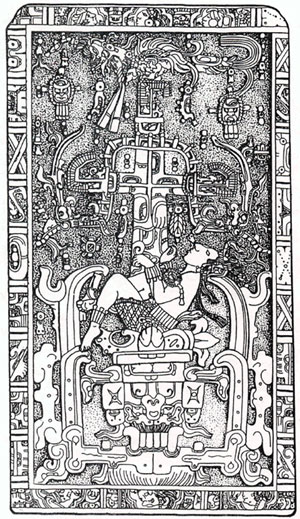
I came came to grips with the image of Pacal's tomb when I arrived at my guesthouse on my stay at Tikal in Guatemala. The rooms were white clay pods and an American Vietnam veteran lived in the back spending his nights staring out through his telescope at the stars. Someone had drawn with a black pen, a perfect representation of Pacal's tomb on to the white clay wall of the pod I slept in.
As I fell asleep I would see the outline of Emperor Pacal, reclining but with his head forward, moving his arms, surrounded by magical forms and dancing symbology.
Tikal is one of the greatest jungle-pyramid worlds that one can visit. While I prefer the vastness of Angkor Wat, I was enraptured by the detail of information and glyphs that depicted the Mayan's deep understanding of life, science, and spirituality. Mayan astrology is interpretted here.
Pacal's tomb was discovered in Palenque (in Chiapas, Mexico) in 1952. The Emperor Pacal died on August 31, AD 683 at eighty years of age after ruling for 63 years. detail picture of Pacal's Tomb
Interpretations of what the figure of Pacal on his tomb meant have been helpful, for instance:
- In the Maya dialects, "bone" and "seed" are synonymous.
- The bone piercing Pacal's nose as the symbol of rebirth.
- The object depicted above Pacal is the Tree of Life from which he is said to be falling.
He is no more moving than the universe around him is. The object below him that gets interpreted as the setting sun is escorting him. He embraces his fate. His arms navigate the changing complexity of his surroundings.
Falling asleep with the glyph of Pacal painted on the wall, I found the that the inscription on his tomb was not so much about death, but about the process of transformation, any transformation.
1 comment:
Here's the link to my painting Pascal
http://funkyenough.blogspot.com/2006/07/painting-pascal.html
Post a Comment